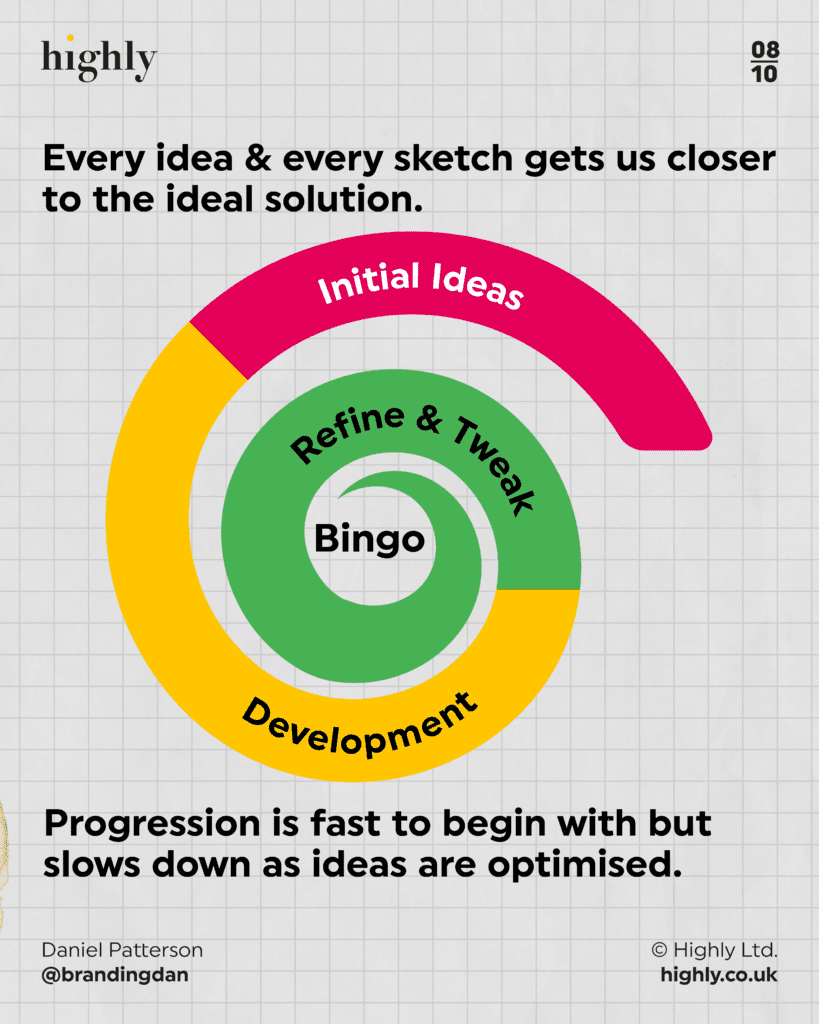It’s true that the simplest things often take the longest time to discover. Things that were seemingly staring you in the face the whole time seem to be blurred out from your eye line. Perhaps they were too close all along. What you really needed was focus and refinement.
Some examples you scream?
Here’s one. The can opener wasn’t invented until 45 years after the can.
Another, you wail? Well, have this. The screwdriver was only invented 3 centuries after the screw. But how did they unscrew things before Josh? How did they UNSCREW?! Teeth, I reckon.
The validity of that final conjecture aside (the first two points really are true!), you’re probably wondering where exactly this is going. Well, how about this: It took Pepsi over 50 years to get to the bottle cap logo we know today. Bottled soda. Their logo… is a bottle cap. You would’ve guessed they might’ve thought of that sooner. But that’s the whole point. It doesn’t always take 50 years or 3 centuries, but good things take time. Simple things take time. The simple solution is often the most direct, which pretty much makes it the best. It should take time.
It’s the same with building a brand. Every element of a brand must be fine tuned in order to produce the most effective piece of work. And for logos, this is especially true.
It’s almost impossible that your first idea will be your best.
It’s vital that you move beyond your initial thought, because the thing about initial thoughts is that they rarely take into consideration a number of important factors outside of your own initial understanding or experience.
Another thing about initial ideas: there’s nothing to compare them to. Having a single idea narrows your vision. You want to believe in it. You want to believe in it so much that you ignore problems that are right in front of you. You get too much in your own head about it. It becomes incredibly difficult to move past it as it means burying and disregarding it. It’s hard to give up your own idea because it’s yours.
But that’s exactly what you need to do.
You need to create distance from your idea in order to look at it more objectively. It’s hard to judge something in the moment. The key thing to remember is you progress along with your ideas. You get better as the ideas get better. You might even look back at the initial idea and feel almost embarrassed about it. This shows how important refinement and distance is.
Ideas progress when you’re open to the idea of more and better ideas. Your initial logo sketch won’t be your last.
SO, HOW DO YOU GO FROM FIRST IDEA TO END PRODUCT?
To get from your first idea to your polished end product you need to do research, mindmap initial ideas, draw preliminary sketches, develop your logo in computer software, refine and tweak your logo until it’s done.
But this is just the simple way of looking at it. Let’s break it down one by one.
Creating a Logo: Research
When I say research I actually mean a couple things.
1: Research your competition
2: Research yourself.
Let’s start with 2.
Before you can think of drawing a logo for your brand, first you need to understand your brand. Ask yourself, what are your brand’s values? What are you trying to communicate? If your brand was a person, what kind of person would they be? Your job is to take that knowledge and bring it to the design process. You want your logo to communicate all of these things.
But what you also want to do is research your competition. The reason for this is so you can better understand what your competitors are doing, and in turn you can address how you can do it differently. You don’t want to blend in, so you need to know what everyone else is doing. And while you’re at it, you can figure out how to do it better. Look for their strengths and their weaknesses. Bring this knowledge to the design table.
Creating A Logo: Initial Ideas
Now you’re finally at the design table, it’s time to start busting out initial ideas. But don’t reach for the pencil quite yet. Right now you’re in the perfect space for mind mapping. This is just your initial creative period. You might use this time for discussion, to work through your research and to form cogent ideas of how you’d like to progress that research.
Don’t be scared of it though, this is the space where creatives often flourish. Minus your research, you’re basically on a blank slate. It’s time to start looking at problems and figuring out, using your research, how you can create solutions. But remember, any idea is just A solution, not THE solution. You don’t stop at your first idea.
Creating A Logo: Preliminary Sketches
Okay, so you’re finally at the design table. Pencil is officially in hand as a baton unto a runner.
This is the stage before you move onto developing your logo in the computer software. In fact, that might be the next stage, but you’re still a long ways before that.
Right now it’s time to sketch your little heart out. Now, there’s no magic number for how many sketches you should be doing. It’s not like you hit 1000 sketches and suddenly see the light. But don’t go calling it quits 10 sketches in. You want to be hitting at least 50-100. But try not to focus on a number. Instead, focus on the words of Highly’s in-house (she works from home…) Graphic Designer, Jordan: “Do as many as you can, and then do some more.” There really is no magic number. You need to exhaust your ideas and spend days or weeks sketching. You even need to sketch those bad ideas – don’t pretend you don’t have any! – because at least they might lead to something great later on. In the case of an agency, they may set a block of time for work so then there’s a time limit. If that’s the case (or in any case really) make sure you don’t get trapped by obsessing over one idea. Get yourself a range of sketches and give yourself some distance in order to fairly judge which ideas can then be fine tuned.
Creating A Logo: Developing Your Logo With Computer Software
Got your 100 logos? Good. Now it’s time to narrow down and take what you’ve got into the digital world.
Your logos may start to come to life here now that you can see them rendered more closely to how they’re meant to look. Just like everything else, you want to keep refining and trying out ideas here. Just because you’ve narrowed down to even just a handful of sketches, it doesn’t mean that any of them are done. Now you’re just getting a different view of them to figure what needs to change and improve. Once that’s done, you might start to have an idea of which logo you want to choose to make it to the final stage…
Creating A Logo: Refining & Tweaking Your Logo
Speaking of the final stage…
It’s time to refine and tweak. Again, there’s no magic number or time here, you just want to take your logo as far as you can at this stage. At this stage, you won’t be making giant leaps forward so much as tiny advances. But don’t be mistaken, every little tweak and adjustment is important. Don’t rush it.
How Do You Know That Your Logo Is Finished?

And that brings us to our final point: How do you know when you’ve got your final end product?
Well, some of the major things to look out for are, does it tick all the boxes you ask at the beginning? That is, does it reflect your values? Does it differ and do better than the competition?
Then the really practical parts. Have you tested it against your target audience? Does it appeal to them? Does it evoke a positive emotional response from them?
These above things are the most important. Remember, there’s no one perfect solution, you’ll never reach perfection at the centre of the spiral, but you can make a lot of progress over a couple weeks if you really give it time. The beginning of the spiral is far from the centre.
And yes, if you’re working with clients, their opinion is important too, just like if it’s your brand your happiness with the logo matters. But at the end of the day that’s not what it’s all about. It’s about how well it can perform. Look at performance and look at effectiveness. Refinement and testing to achieve the most effective performance and biggest target audience engagement stands above all other things.
But really, when all’s said and done, if you’re willing to do everything we’ve gone through above while being brave enough to bury any of your ideas if needed in order to start with a completely blank page, you’ll surely be on your way to something good.

